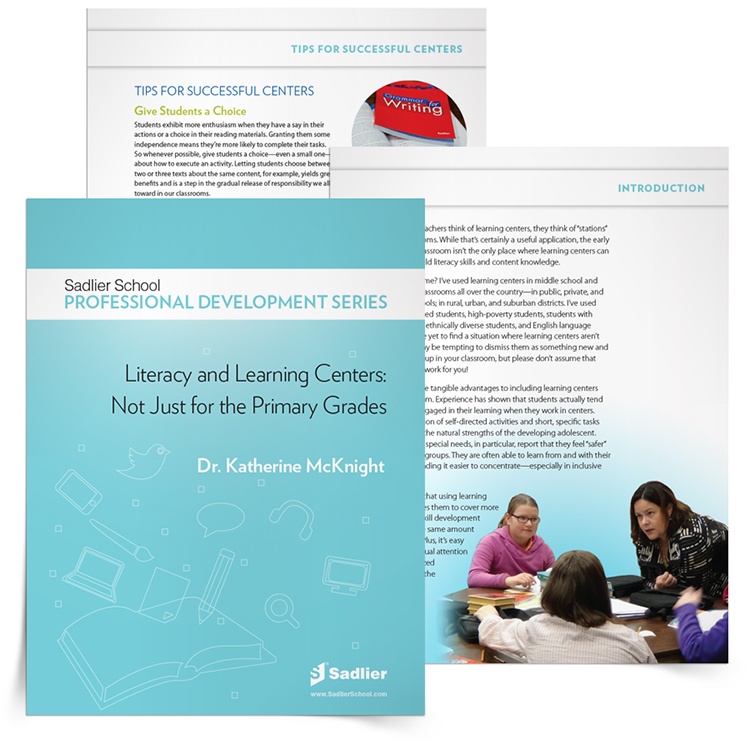May 10, 2016 ELA 6-8, ELA Resources - Tip Sheets, ELA Focus - Writing, ELA 9-12, ELA PD - Grammar Writing, ELA Focus - Grammar, Core Grammar
Setting Up Classroom Writing Centers in the Upper Grade Levels
By: Tiffany Rehbein
Last year, I hosted a lab classroom where teachers observed my classroom through the lens of questions they had in their own practice. Teachers visited my tenth grade classroom where students were working in writing centers – collaborative centers that require students to apply literacy skills and content knowledge.
 There are a number of benefits to implementing writing centers in the upper grade levels. Classroom writing centers provide teachers and students opportunities to engage fully in the writing process. Teachers can provide formative feedback that develops student learning. Teachers can also offer multiple interventions for students including the following: a) address gaps in learning; b) enhance knowledge and skills that students need to be successful in writing; c) offer activities that are designed to promote mastery of literacy skills and content knowledge; d) provide descriptive feedback to foster student skill development mastery and content knowledge; e) include a teacher-led center to address individual learning needs.
There are a number of benefits to implementing writing centers in the upper grade levels. Classroom writing centers provide teachers and students opportunities to engage fully in the writing process. Teachers can provide formative feedback that develops student learning. Teachers can also offer multiple interventions for students including the following: a) address gaps in learning; b) enhance knowledge and skills that students need to be successful in writing; c) offer activities that are designed to promote mastery of literacy skills and content knowledge; d) provide descriptive feedback to foster student skill development mastery and content knowledge; e) include a teacher-led center to address individual learning needs.
Writing Center Activities
Returning to my classroom example, grammar was the focus of the writing center activities, so each center had a grammatical purpose. I chose five writing center activities based on students writing and where they needed the most support.
In one center, students drew “marker words” from a pile and wrote sentences that included dependent and independent clauses. In another center, students wrote a group story. I provided an opener and students added to the opener. The focus of the center was idea development. Students wrote one sentence and passed their papers around the center, adding to the work of others. In another center, I had complex and compound-complex sentences cut into strips (including the punctuation). Students worked together to put the sentences together. This center supported students who learn better kinesthetically. In another center, I provided students with three rules to use semicolons. Students wrote sentences using each type of semicolon. Students checked each other’s work and made corrections. All of this grammar instruction was embedded within a writing assignment: the personal essay. In the teacher-led center, I provided a mini-lesson on writing introductions. When students were conducting independent practice, I checked in on the other writing centers. There was a time limit on each center, so students had a focused time to complete purposeful work.
Students were writing, collaborating, and using the writing process to improve their own texts in the writing centers.
Setting Up Your Classroom Writing Centers
There are a number of logistical elements when setting up classroom writing centers. The physical space is the phase to implement. The seating must be conducive to student collaboration. Below are a few things to keep in mind when setting up the physical space of your classroom writing centers:
- Change the physical environment
- Seating arrangements should be conducive to student collaboration and teacher check-ins
- Offer a mini-lesson
- This can happen once or twice a week
- Give an overview of the writing center arrangement
- If students are rotating and each center is different explain and outline expectations
- Provide multiple writing opportunities
- Remember student collaboration
- Utilize positive feedback to improve student writing
Choosing Topics & Assessing Student’s Writing
Writing centers can begin in a number of ways. In my example, I gave an overview of the day. I chose the writing center topics based on student writing and where they needed the most support. In that case, the mini-lesson was conducted in small groups four times during the class period. In other cases, the class time might begin with a whole-class mini lesson. The lesson should have one specific focus on content knowledge or a literacy skill. Mini-lessons need not be used during every class period.
In my classroom example, students moved from one center to another after a specific time limit. This might also be modified with students in each writing center working on the same task. In this case, the teacher might have more flexibility moving from group to group to formatively assess student’s writing.
If you are looking for another set of examples to use in writing centers, here are some examples for students:
- If using the 6 Traits of Writing, for each trait, have students choose one thing from their paper that they like best, and tell why they like it
- If using the 6 Traits of Writing, for each trait, have students choose one thing from their paper that they think could be improved, and ask for feedback from the group. Give lots of details to support your opinion.
- Use the read aloud.
- Add to idea development.
- Find a paragraph that is confusing or that the student is struggling with and read it out loud. Have peers offer feedback for improvement.
- Pick specific parts of the piece to talk about.
- In the teacher-led center, have students come with specific questions where they want support.
In conclusion, writing centers allow for student choice and multi-tiered interventions appropriate to student needs. Writing centers also allow for deep student engagement and let teachers have an opportunity to give specific feedback on student writing.
To learn more about how centers can be used in the upper grade levels, download Dr. Katherine McKnights eBook: Learning and Literacy Centers, Not Just for the Primary Grades.




